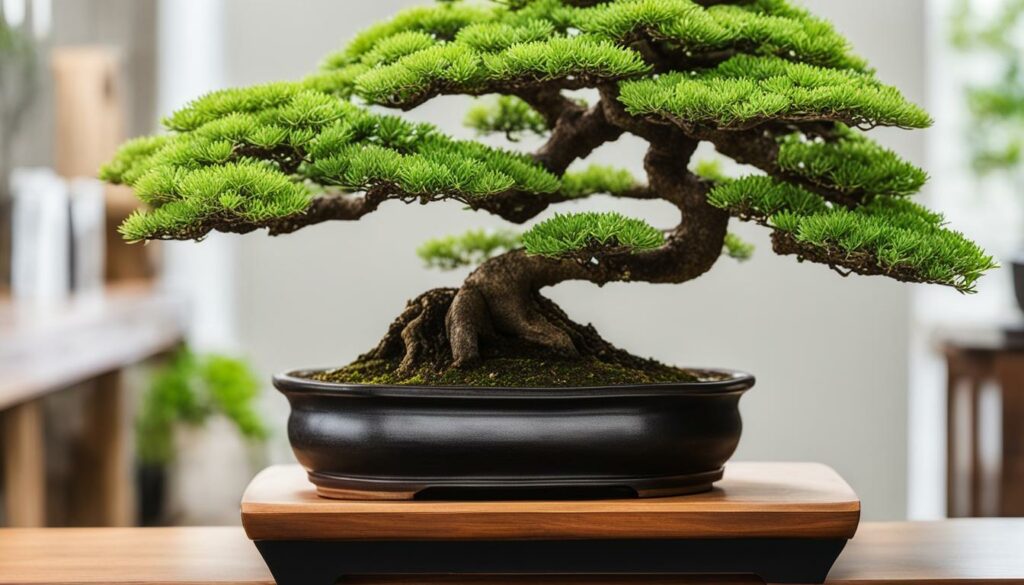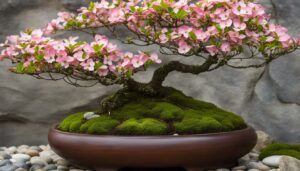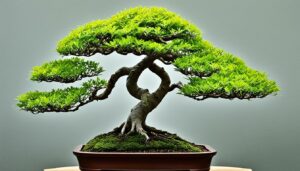Unlock the serenity of nature within your home with the elegant art of bonsai. Opting for the best bonsai for indoors not only embellishes your living space but also introduces the joy of small space gardening. As you embark on your journey through this miniature tree guide, you’ll discover a plethora of indoor bonsai tree varieties perfect for the tranquil art of cultivating miniature landscapes. These tiny arboreal wonders offer a lush retreat right in your living quarters, turning your domicile into a haven of green tranquility.
Key Takeaways:
- Discover the perfect indoor bonsai to fit your lifestyle and space requirements.
- Learn which tree species excel in the indoor bonsai environment.
- Gain insight into the benefits of adding a bonsai to your small space gardening endeavors.
- Explore the significance of choosing the right tree for successful indoor bonsai cultivation.
- Uncover tips for nurturing and viewing these living sculptures in your own home.
Understanding the Art of Bonsai
Embarking on the journey of bonsai cultivation is to walk a path lined with history and tradition. Bonsai are not merely plants; they are a testament to the enduring relationship between nature and the human spirit—a blend of art, science, and philosophical endeavor.
The History of Bonsai Cultivation
The origins of bonsai cultivation stretch back over a millennium, rooted in the landscapes of China before the practice was embraced and refined in Japan. Recognized as a form of living sculpture, bonsais reflect the reverence for nature and the pursuit of harmony. Understanding the rich bonsai cultivation history allows one to appreciate the depth behind each miniature tree.
Caring for a Living Sculpture in Your Home
Each bonsai tree is a living work of art, requiring dedication and an understanding of artistic indoor bonsai care. These living sculptures need more than just soil and water—they crave your attention and artistic touch. From the strategic placement near a window to the careful snipping of leaves, the care you invest animates the very essence of the bonsai.
| Care Aspect | Description | Benefits |
|---|---|---|
| Watering | Consistent hydration tailored to the bonsai’s needs | Ensures health and vitality of the plant |
| Pruning | Regular trimming to shape the bonsai’s aesthetic | Encourages growth and maintains desired form |
| Positioning | Placing your bonsai in an ideal location for light and temperature | Optimizes conditions for a thriving miniature ecosystem |
By engaging in the art of bonsai, you are not just cultivating a plant; you are nurturing a living canvas. The emotional benefits of caring for these precious entities resonate deeply, creating a sense of tranquility and accomplishment in their caretaker.
Essential Tools for Indoor Bonsai Care
A well-maintained indoor bonsai garden is a source of peace and beauty. To achieve this, the right bonsai maintenance tools are not just helpful, but necessary for the health and aesthetics of your miniature trees. From shaping to watering, every action you take can influence the vitality of your bonsai. Below is a list of indoor bonsai garden essentials that you should consider incorporating into your toolkit.
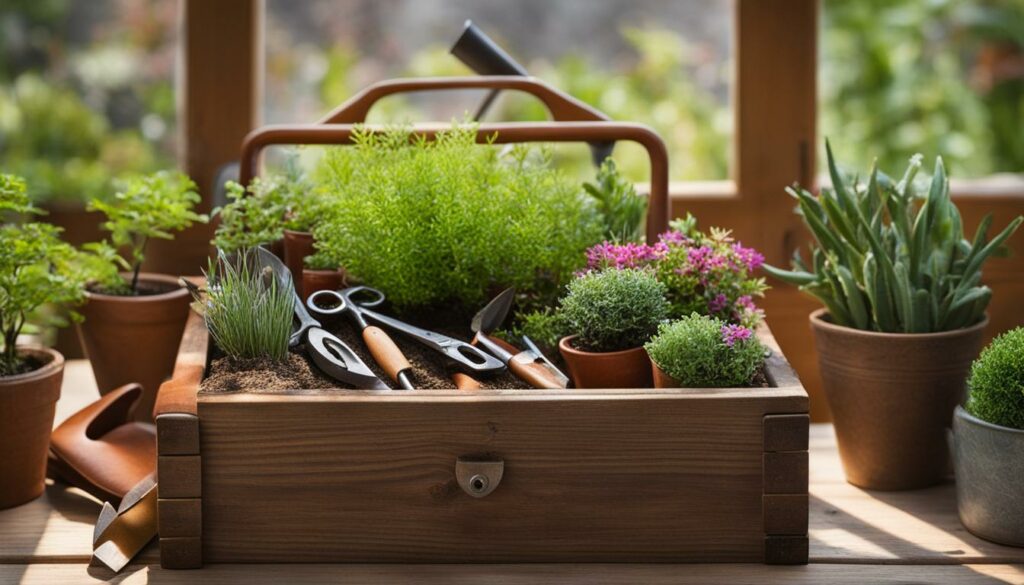
- Pruning Shears: Sharp and precise, these allow you to shape your bonsai and control its growth by removing unnecessary branches and leaves.
- Wire Cutters: Essential for applying and removing wires when shaping branches and trunks. Always opt for a pair designed specifically for bonsai to avoid damaging your tree.
- Watering Can: A can with a fine nozzle offers control over the watering process, ensuring your bonsai receives moisture without soil erosion.
Your toolkit should also consist of various other implements that aid in maintaining the perfect indoor bonsai environment:
| Tool | Function | Use Frequency |
|---|---|---|
| Soil Scoops | For adding or removing soil without making a mess | As needed during potting |
| Bonsai Fertilizer | Provides essential nutrients that indoor bonsai might lack | Every other month |
| Humidity Tray | Maintains necessary moisture levels around your bonsai | Daily monitoring |
| Moss Spores | Enhances the aesthetic of the pot and maintains soil moisture | Applied yearly or as needed |
Whether you’re a veteran bonsai enthusiast or a novice starting your indoor bonsai garden, investing in these crucial tools will help ensure your exquisite miniature trees live long, healthy lives. Remember, the goal is not just to sustain but to enhance, showcasing the splendor that bonsai trees are known for.
Selecting the Perfect Container for Your Indoor Bonsai
Embarking on the journey of bonsai cultivation, one of the first crucial decisions you’ll face is bonsai container selection. Not only does the container contribute to the aesthetic harmony of your miniature tree, but it also plays a pivotal role in your bonsai’s health and growth.
Finding the Right Size and Shape
When assessing bonsai pot size and shape, it’s essential to balance form and function. A pot too small may constrict root growth, hindering your bonsai’s development, while one too large could potentially lead to water-logging and soil nutrients dilution.
- Shallow pots are typically used for most bonsai, enhancing the proportionate appearance of the tree.
- Deep pots may be necessary for species with vigorous root systems, providing extra space and stability.
- Oval or rectangular shapes can complement the fluid lines of a windswept or cascading bonsai, while a formal upright style may pair well with a round or square pot.
Selecting a pot that harmonizes with your bonsai’s appearance is crucial. Visualize the finished composition of the tree and pot as a single entity to ensure that the pot’s style reflects the aesthetic and character of your bonsai.
Drainage and Porosity Considerations
Equally important to aesthetics is ensuring adequate container drainage for bonsai. Proper drainage prevents water accumulation at the roots, which can cause fungal infections and root rot. Thus, your chosen container must have sufficient drainage holes.
Porosity contributes to air circulation within the soil, promoting healthy root growth. Materials such as unglazed clay or terra-cotta are porous and allow for moisture and air exchange, making them preferred choices among bonsai enthusiasts for their practical and natural appearance.
| Container Material | Drainage Quality | Porosity |
|---|---|---|
| Unglazed Clay | High | High |
| Glazed Ceramic | Medium to High | Low to Medium |
| Plastic | Variable (depends on design) | Low |
| Wood | Low to Medium | Low |
| Concrete | Low | Low |
Ultimately, selecting the correct container is a harmonious blend of practicality and aesthetics that will enhance your bonsai’s beauty and ensure its health. Careful examination of these elements before purchasing your container will set you on a path to success in your bonsai endeavors.
The Role of Soil in Bonsai Health
As a bonsai enthusiast, you recognize that the vitality of your miniature trees heavily depends on the substrate they’re rooted in. Just as every tree in nature thrives in the right soil conditions, bonsai trees require special attention to their soil health to ensure they live long, flourishing lives within the confines of their containers.
Choosing the Right Soil Mix
Achieving the ideal soil mix for bonsai is foundational to the success of growing these miniaturized trees. The perfect blend needs to provide adequate support, drainage, and aeration, intricacies that may vary depending on the species of your bonsai. There is a delicate balance to be found – the mix must retain enough water to meet the tree’s needs without becoming waterlogged and causing root rot.
The Importance of Soil pH and Fertilizers
The correct soil pH for bonsai plays a crucial role in maintaining health as it affects the tree’s ability to absorb nutrients. Most bonsai prefer a slightly acidic to neutral pH, but this can differ with species. To maintain the pH balance and nutrient levels, bonsai fertilizers should be applied with precision—over-fertilization can cause as much harm as deficiency.
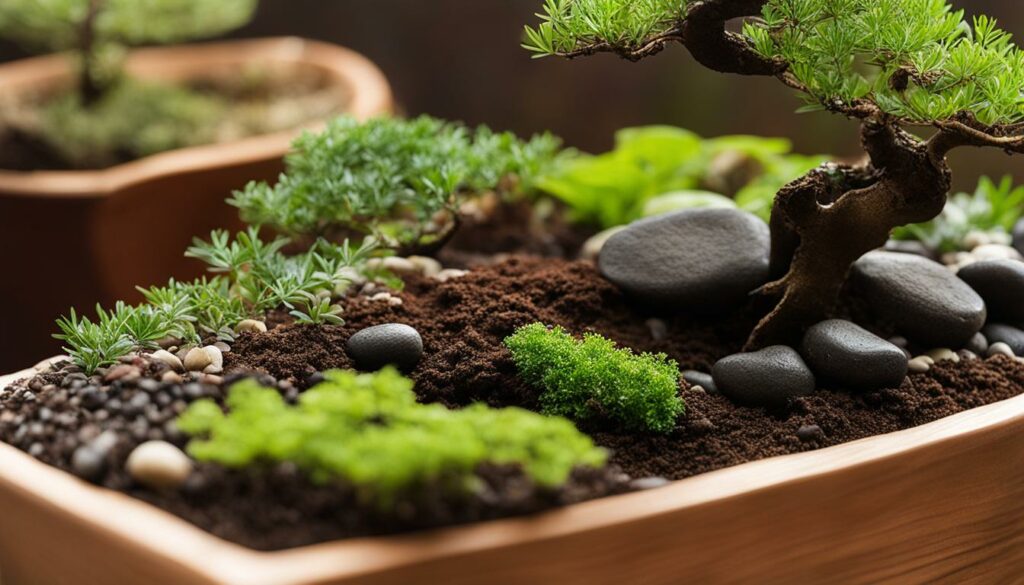
| Component | Purpose | Benefits |
|---|---|---|
| Akadama | Primary substrate | Excellent water retention and drainage |
| Pumice | Aeration | Improves soil structure and root oxygenation |
| Lava Rock | Drainage | Prevents soil compaction, enhances drainage |
| Organic Matter | Nutrient supply | Supplies essential nutrients, retains moisture |
By investing the time to understand and maintain your bonsai’s soil health, you’re not only fostering an ideal environment for your miniature tree but also creating a strong foundation for its future growth and beauty. After all, the essence of bonsai lies in the harmony of elements—soil being the very earth in which this art form’s roots lie.
Watering Techniques for Indoor Bonsai Trees
Maintaining proper watering for bonsai is a vital aspect of indoor bonsai care. It’s a delicate balance that requires attention and understanding of your bonsai’s specific needs. Over-watering can lead to root rot, while under-watering can quickly dehydrate your bonsai. Here are some actionable tips to ensure your indoor bonsai hydration is optimal for its health and growth.
To recognize when your bonsai needs water, check the topsoil. If it feels dry about an inch down, it’s time to water. However, this can vary based on the humidity and temperature of your home. It’s also essential to understand that the watering frequency of a bonsai differs between species, sizes, and even the time of year.
When you water your bonsai, do so thoroughly. Water should be administered until it drains out of the holes in the bottom of your pot, ensuring full hydration of the root system. Below is a guideline that can help you determine your bonsai watering approach:
| Season | Indication for Watering | Watering Frequency Suggestion |
|---|---|---|
| Spring/Summer | Topsoil dryness | Every one to two days |
| Autumn/Winter | Topsoil dry 1 to 2 inches down | Every two to four days |
| Year-Round | Presence of wilting leaves | Immediate watering |
- Use room temperature water to avoid shocking the roots.
- Morning is generally the best time to water your bonsai.
- Invest in a watering can with a fine nozzle to distribute water evenly and gently.
- Never let your bonsai sit in water; ensure excess water can drain away.
Remember, every bonsai is unique and so are its water requirements. Monitor your tree closely, get to know its needs, and you’ll master the art of indoor bonsai hydration.
Pruning and Training Your Bonsai Tree
Understanding how to accurately prune and train bonsai trees is integral to revealing their true aesthetic potential. Bonsai pruning techniques not only help to maintain the miniature size of these trees but also encourage a more robust and pleasing shape. Moreover, training bonsai trees with various wiring methods enables you to guide their growth and sculpt their form over time.
Basic Pruning Steps
Beginning with pruning, it’s essential to grasp the basic steps:
- Identify which branches to prune by considering the overall shape and balance of the tree.
- Make clean cuts using sharp bonsai scissors, and target growth that disrupts the tree’s form.
- Prune back new growth regularly to encourage branching and create denser foliage.
- Remove dead or diseased wood to maintain the health and appearance of your bonsai.
Proper execution of these steps will keep your bonsai looking meticulously groomed and in good health.
Advanced Wiring Techniques
When advancing to bonsai wiring methods, precision and care are paramount:
- Choose the appropriate gauge of wire to match the thickness of the branch being trained.
- Wrap the wire snugly around the branch but allow enough room for growth.
- Gradually shape the branch by bending it into the desired position.
- Monitor the tree’s growth and remove the wire before it begins to cut into the bark.
Wiring is an art and can take some practice to perfect. However, it’s a powerful technique for molding your bonsai’s architecture.
“Training and pruning are the essence of bonsai art; every cut we make, every wire we place is a thoughtful step towards our imagined aesthetic.”
Ultimately, regular maintenance using the right bonsai pruning techniques and bonsai wiring methods ensures that your bonsai is not only living but thriving under your watchful eye and skilled hands. Just as a painter chooses their brush strokes wisely, a bonsai enthusiast uses their tools with intent and understanding.
The Value of Sunlight and Positioning for Bonsai
Mastering the nuances of bonsai care includes understanding just how fundamental sunlight and proper positioning are to your miniature tree’s vitality. Factors such as intensity and duration of light exposure can make or break the health of your bonsai.
Understanding Light Requirements
Each species of bonsai has unique bonsai sunlight needs. Some thrive in the soft morning rays, whereas others may demand full sun to reach their potential. It’s essential to identify what amount and type of light best suits your bonsai to ensure it flourishes indoors.
Best Practices for Indoor Bonsai Positioning
Positioning indoor bonsai trees strategically around your home is an art of its own. The goal is to mimic the tree’s natural environment, providing enough light throughout the day without exposing it to harmful extremes.
| Bonsai Type | Light Requirements | Recommended Indoor Positioning |
|---|---|---|
| Ficus Bonsai | High indirect light | Near a south-facing window with sheer curtains |
| Juniper Bonsai | Direct sunlight | Close to a south-west facing window |
| Pine Bonsai | Bright, direct light | On a sunlit patio or by a skylight |
| Azalea Bonsai | Partial sun | East or west-facing window receiving morning or evening light |
Remember, exposure to the right quantity and quality of light not only strengthens the foliage but also plays a crucial role in flower and fruit production for certain species. Adjust positions with the changing seasons to maximize your bonsai’s exposure to the health-giving benefits of sunlight.
Ficus: The Ideal Beginner’s Bonsai Tree Species Indoor
If you’re embarking on the enchanting journey of bonsai cultivation, the Ficus bonsai is an outstanding choice to consider. Known for being robust and tolerant, it’s a beginner-friendly bonsai that thrives well indoors. In this section, we delve into the basics of indoor Ficus bonsai advice that will help you understand why the Ficus is such a suitable starting point for neophyte enthusiasts.
Caring for a Ficus bonsai involves several key factors that contribute to its reputation as an ideal beginner’s plant. The Ficus species possess a resilience to some of the most common errors made by novices, such as inconsistent watering and suboptimal light conditions. Here’s a primer on how to foster a thriving Ficus bonsai in your home.
- Light: Ensure your Ficus gets plenty of indirect, bright light. It can cope with some shade but thrives best with good lighting conditions.
- Watering: Water your Ficus when the soil gets slightly dry to the touch. Ficus bonsai trees are forgiving if you occasionally forget to water.
- Feeding: Use a general-purpose liquid fertilizer every month during the growing season to encourage robust growth.
- Pruning: This species responds well to pruning, which can be done throughout the year. It’s an excellent way to practice your pruning skills.
- Repotting: Younger Ficus trees should be repotted every two years, while older ones can be repotted less frequently.
When it comes to pests and diseases, Ficus bonsai are less susceptible than other species, which makes them even more favorable for beginners. Nonetheless, be vigilant and keep an eye out for signs of stress in your bonsai, such as dropping leaves or stunted growth, and address issues promptly to prevent more significant problems.
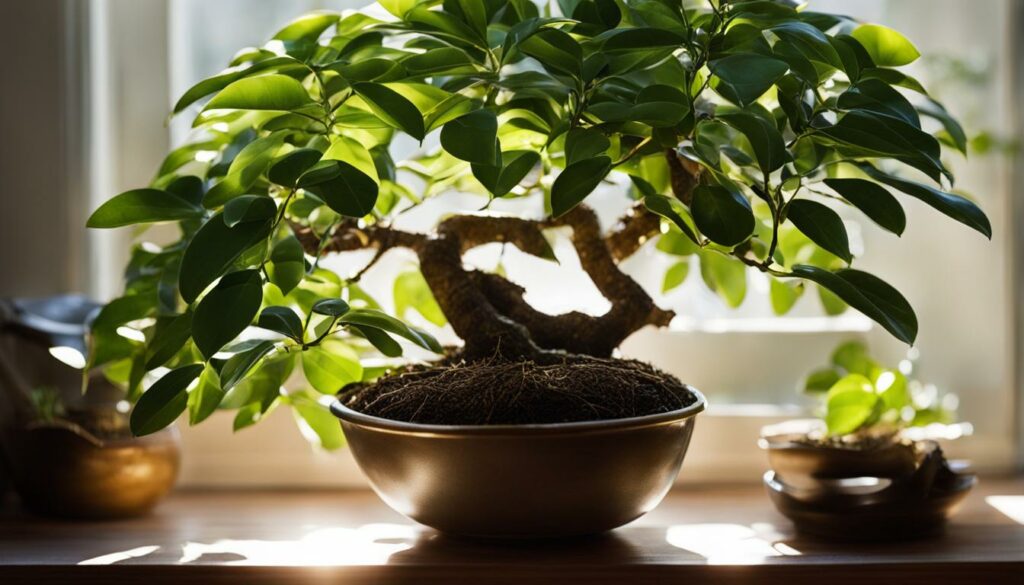
Remember, the golden rule of Ficus bonsai care is consistency. With consistent care, the right environment, and a bit of patience, your indoor Ficus bonsai can become a green centerpiece in your home, radiating tranquility and the subtle beauty that is synonymous with the art of bonsai.
In summary, if you have limited experience or are just beginning, the Ficus is certainly one of the most forgiving and rewarding bonsai varieties to start with. It is not just the resilience of the Ficus that makes it ideal but also its aesthetic flexibility, allowing you to shape and train it in accordance with your vision, adding to the personalized touch of your indoor garden.
Caring for Indoor Conifers: Juniper and Pine
While many bonsai aficionados prefer traditional outdoor settings for their coniferous treasures, the allure of indoor bonsai cannot be overlooked. The juniper bonsai, with its resilience, and the pine bonsai, with its stately form, have distinct needs when brought into the domestic realm. It’s essential to calibrate your care approach for these species to thrive within the home environment.
Juniper Bonsai Care Guide
Juniper bonsai indoor care hinges on replicating the zenith of alpine conditions. These species bode well with cooler temperatures and ample light. For indoor cultivation, ensure your juniper bonsai is positioned where it receives steady, indirect sunlight and is shielded from the dry warmth of heating systems. Moderate humidity and consistent watering will prevent the needles from drying, mirroring the bonsai’s natural habitat.
- Lighting: Choose a spot with bright, filtered light.
- Watering: Maintain a regular watering schedule, allowing the soil to dry slightly between intervals.
- Humidity: Use a humidity tray or mist frequently to recreate the juniper’s preferred moist conditions.
Pine Bonsai Prerequisites
Pine bonsai maintenance calls for a deft hand and an understanding of its seasonal cycles. Indoor pines demand a cool winter period to rest and a bright exposure during growing months. Balancing the watering cycle is crucial; the soil should be well-draining to avert root rot, a common ailment in insufficiently cared for bonsai pines.
- Winter dormancy: Allow your pine to experience a cooler period during winter.
- Spring awakening: Gradually increase water and light as the bonsai enters its growth phase.
- Soil specification: Employ a soil mixture that supports excellent drainage while retaining enough moisture.
| Aspect | Juniper Bonsai | Pine Bonsai |
|---|---|---|
| Light | Indirect, bright light | Direct sunlight during growth periods |
| Temperature | Cool, mimicking high altitude conditions | Cool winters; moderate during growing season |
| Watering | Consistent, allow for slight drying | Consistent, with excellent drainage |
| Humidity | Increased with trays or misting | Normal household levels, not too dry |
| Soil Type | Well-draining with organic content | Well-draining with pumice or lava rock |
Bearing in mind these conifer bonsai tips, both novices and seasoned enthusiasts can cultivate the revered juniper and pine bonsai indoors. Patience and attentive care are your allies in accommodating these magnificent trees to an indoor setting while preserving their stoic beauty.
Bright and Beautiful: Caring for Flowering Bonsai Species
Embrace the vibrant allure of flowering bonsai care, an aspect of the bonsai art that brings a burst of color to any indoor space. Flowering bonsai trees are a feast for the eyes, with their delicate blossoms promising a joyous display amidst the serene backdrop of meticulously arranged leaves and branches. Perfecting the care of these indoor blooming bonsai varieties will ensure they flourish, providing year-round beauty and an engaging challenge to bonsai enthusiasts.
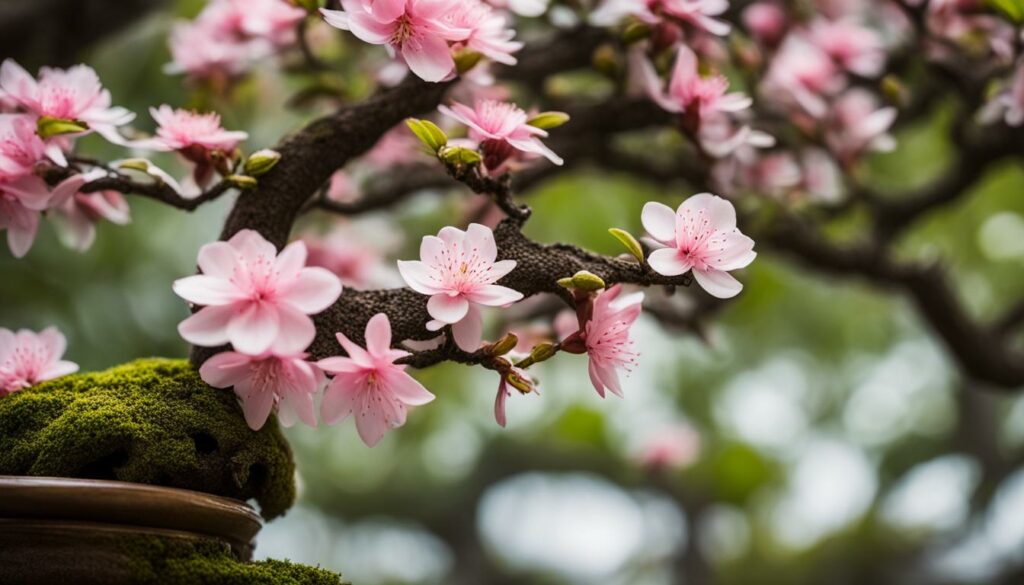
To begin, consider the fundamental care techniques required to keep your flowering bonsai vibrant and healthy. This encompasses a balanced watering routine, exposure to adequate lighting, and the application of well-timed fertilizer treatments to promote blooming. Understanding the unique needs of your bonsai’s species is imperative for achieving a display rich in blossoms.
Here is a breakdown of a few popular flowering bonsai species and their basic care requirements:
| Species | Watering Frequency | Sunlight | Fertilization |
|---|---|---|---|
| Azalea (Rhododendron) | Moderate to High | Partial Shade | High Phosphorus during blooming season |
| Bougainvillea | Low to Moderate | Full Sun | Balanced NPK during growth; low Nitrogen when flowering |
| Jasmine | Moderate | Full to Partial Sun | Balanced fertilizer every few weeks |
Each species requires a tailored approach to achieve and maintain its flowering potential. For instance, the Azalea bonsai, with its lush, vivid blooms, thrives in a well-drained, acidic soil mix, while the hardy Bougainvillea is forgiving of drier conditions and loves to bask in the full sun.
During the flowering period, extra attention should be given to nutrient delivery. Without adequate fertilization, your bonsai may fall short of producing the spectacular blooms for which they are known. That being said, be cautious of over-fertilizing which can lead to burn or excessive foliage growth at the expense of flowers.
Remember to adjust your care techniques with the changing seasons. And most importantly, stay consistent with care, providing a stable environment for your indoor bonsai to prevent stress that could hinder blooming.
Incorporating these tips into your flowering bonsai care routine, you’ll be well-equipped to enjoy the living art of bonsai in its most colorful form. Allow these indoor blooming bonsai varieties to inspire your space, and they’ll reward you with a delightful show of flowers that mirrors the natural beauty of the seasons.
Creating Humidity for Tropical Bonsai Trees
Maintaining the delicate balance of tropical bonsai humidity is key to the health of your indoor bonsai collection. Unlike their temperate counterparts, tropical bonsai thrive in more humid environments, similar to their natural habitat. Achieving suitable indoor bonsai moisture levels can be challenging, but with the right techniques, you can create a lush oasis that supports their lush growth.
Why Humidity Matters
For tropical bonsai trees, the level of humidity in the air is just as critical as the soil moisture at their roots. Leaf transpiration and respirational health are directly influenced by the surrounding air; without adequate humidity, your bonsai may suffer from dry leaves, stunted growth, and increased vulnerability to pests. Consequently, replicating the high humidity of a tropical climate indoors is essential for your tree’s vitality.
Methods to Increase Humidity at Home
Creating the right microclimate within your home requires both innovative and traditional methods. Here are some tried and tested ways to boost humidity for your tropical bonsai:
- Misting: Regularly misting your bonsai can temporarily increase air moisture but should be used in conjunction with other methods for a more consistent effect.
- Humidifier: Using a room humidifier is one of the most effective ways to control the humidity level for indoor bonsai trees.
- Tray with water and pebbles: Placing your bonsai on a tray lined with pebbles and water can help increase the local humidity as the water evaporates around the tree.
- Grouping plants: Plants naturally transpire, so placing several plants together can create a microcosm of higher humidity.
Each of these methods can transform your home into a tropical bonsai-friendly environment, nurturing your miniaturized trees to their fullest potential.
Pest Management and Disease Prevention in Bonsai
Ensuring the vigor of your indoor bonsai tree health involves steadfast vigilance against pests and diseases. The miniature world of bonsai can be threatened by the same adversaries that plague full-sized counterparts. Let’s delve into tactics for bonsai pest control and preventing bonsai diseases to maintain the serenity of your indoor garden.
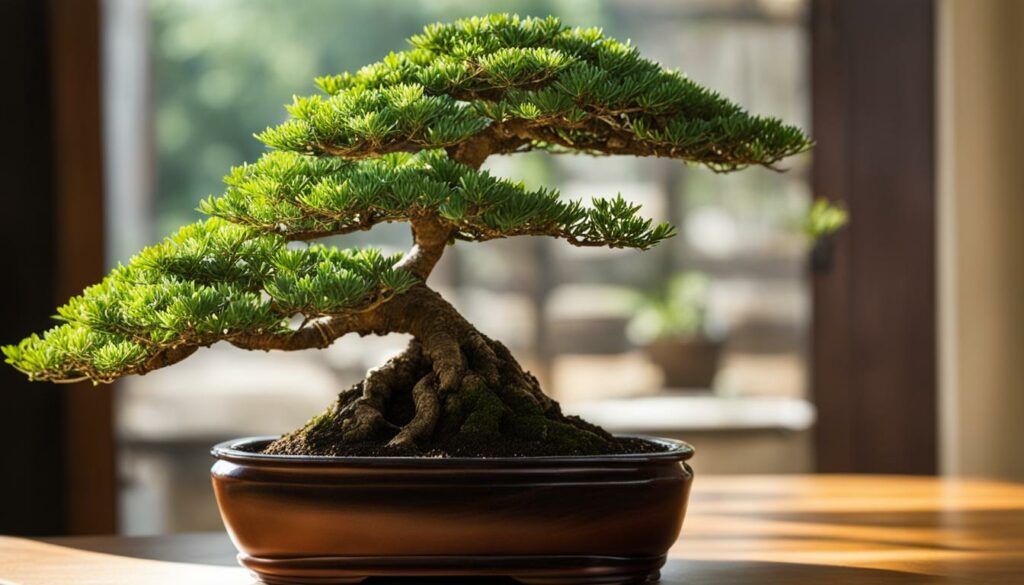
To begin, recognize that a healthy bonsai is your first line of defense. Adequate watering, proper feeding, and correct lighting conditions make for a robust bonsai less likely to succumb to infections or infestations. However, when pests or diseases do strike, early detection and proper identification become crucial in effective management.
- Inspect your bonsai regularly for signs of distress, such as unusual leaf drop, spotting, or a sticky residue that could indicate the presence of pests like aphids, spider mites, or scale insects.
- Isolation of affected plants is key to preventing the spread of any problems to other bonsai in your collection.
- Clean foliage using a mild soap solution can be effective in removing pests without resorting to harsh chemicals.
- Introducing natural predators, like ladybugs, can provide biological control of pest populations.
When it comes to diseases, maintaining an environment that discourages fungal and bacterial growth is essential. For instance, ensuring that your bonsai’s soil drains properly and isn’t continuously damp can drastically reduce the risk of root rot and other common afflictions.
Remember, the best cure is prevention. Diligence in daily care is the guardian of indoor bonsai tree health.
Repotting Practices for Healthy Bonsai
Ensuring your bonsai thrives involves regular maintenance, which includes repotting to promote bonsai root health. By understanding when and how to repot, you can maintain the ethereal beauty and structure of your miniature tree for years to come.
Recognizing When to Repot
Several signs indicate the necessity of repotting bonsai. Observe when the roots circle the pot’s bottom or if the tree becomes top-heavy and prone to tipping. A slowed growth or extended periods between waterings can also signal that it’s time to repot your indoor bonsai.
Step-by-Step Guide to Repotting
When you’ve recognized that your bonsai requires repotting, follow this indoor bonsai step-by-step guide while being gentle to ensure minimal stress to the plant:
- Prepare your new pot with a layer of soil mix designed for bonsai, considering proper aeration and drainage.
- Gently remove the bonsai from its current pot, carefully detangling the roots if necessary.
- Trim away any dead or overly long roots to promote fresh growth, keeping a keen eye on maintaining essential root structure.
- Position the bonsai in its new container and fill it with soil, ensuring even distribution around the roots.
- Water your repotted bonsai thoroughly, and place it in a location that mirrors its previous light exposure and temperature conditions.
Remember, the best time to repot is typically in early spring as the bonsai comes out of its dormant winter phase. This gives your bonsai a full growing season to establish itself after the trauma of repotting.
| Before Repotting | After Repotting |
|---|---|
| Roots circling the bottom of the pot | Freshly trimmed roots with room to grow |
| Slowed bonsai growth | Potential for increased vigor and health |
| Long interval between waterings | Soil moisture levels more balanced |
| Top-heavy and unstable bonsai | Firmly seated and stable in the new pot |
With these tips on repotting bonsai, you can keep your miniature tree looking its best and ensure it has the space and resources needed to flourish. In addition to aesthetic considerations, repotting is essential to the overall health of your bonsai, and regular attention to this task will contribute to a thriving indoor garden.
Bonsai Styling: Achieving Aesthetic Appeal
Styling bonsai trees is a contemplative yet creative endeavor that fuses nature and artistry into one. To craft a bonsai that resonates with the serene beauty of the art form and maintains indoor bonsai aesthetics, it’s essential to learn and apply a variety of bonsai design techniques. As you embark on this journey, you’ll discover that each tree has its unique characteristics that can be highlighted through styling. Below, you’ll find guidance on shaping your bonsai that not only brings out its natural beauty but also adheres to revered bonsai forms.
The process begins with visualizing the tree’s future form. One of the first steps is selecting the front, which sets the stage for all design choices that follow. Consider the tree’s flow, the arrangement of its branches, and any unique features such as an interesting trunk line or exposed roots known as ‘nebari’.
Here is a comprehensive table that outlines the fundamental styles and design techniques for styling your bonsai:
| Style | Description | Branch and Trunk Formation | Ideal for Species |
|---|---|---|---|
| Formal Upright | A perfectly vertical trunk with symmetrical branching. | First branch opposite the direction of the lean, second branch on the other side, third towards the back. | Pines, Junipers |
| Informal Upright | A trunk with gentle curves and relaxed branching pattern. | Branch placement should follow natural growth, alternating levels. | Maples, Elms |
| Slanting | A trunk that leans at an angle, often resembling a tree blown by wind. | First branch should spread in the opposite direction of the lean to balance the composition. | Spruce, Ficus |
| Cascade | Branches and trunk cascade downwards, mimicking a tree growing on a steep cliff. | Main branch cascades below the pot’s base, secondary branches positioned higher for depth. | Junipers, Cedars |
| Semi-Cascade | Trunk grows upright then bends sharply, with branches extending to the side. | Main branch projects slightly below the rim of the pot, with ascending secondary branches. | Azaleas, Conifers |
Pruning is your primary method of shaping, but patience is key. Make thoughtful cuts to develop foliage pads and reveal the trunk. Additionally, wiring can be used to direct growth and refine branch placement over time. Both techniques require practice to perfect and should be carried out with a vision in mind.
- Use pruning during the growing season to shape foliage and maintain the tree’s size.
- Wiring can be done almost year-round, but monitor the wire to prevent it from cutting into the growing bark.
- Practice selective pruning on new shoots to maintain the shape without hindering growth.
Remember, patience is the companion of wisdom when it comes to the art of bonsai. Your tree is a living sculpture, ever-changing and growing with each season. The time and care you invest in your bonsai’s styling are rewarded with a serene and balanced natural piece that synchronizes with your indoor living space.
As your bonsai matures, continual evaluation and subtle adjustments in your styling approach will be necessary to keep it aesthetically balanced. Harness these principles of design, and enjoy the profound satisfaction that comes from the ancient art of styling bonsai trees.
Joining the Bonsai Community: Clubs and Resources
For the ardent bonsai enthusiast, finding a group of passionate individuals with whom to share your interests can be incredibly fulfilling. Whether you’re new to the art or a seasoned practitioner, the collective knowledge and experience found within the bonsai community can significantly enhance your own understanding and enjoyment of bonsai. Engaging with local bonsai resources, joining online bonsai clubs, and participating in bonsai community involvement are excellent ways to deepen your connection with this captivating hobby.
Local Bonsai Clubs
Local bonsai clubs offer a bounty of benefits, including hands-on workshops, demonstrations from experienced members, and the opportunity to participate in regional events. Being part of such a club allows you to gain insights from other bonsai enthusiasts and build connections that can last a lifetime.
Online Forums and Social Media Groups
In the digital age, online forums and social media groups provide a virtual meeting ground for bonsai lovers the world over. These platforms are ideal for swapping tips, seeking advice, and showcasing your bonsai progress. The immediacy of online interactions means you can enjoy bonsai community involvement from the comfort of your home or garden.
- Search for local bonsai clubs in your area and attend a meeting.
- Join online discussion boards dedicated to the art of bonsai.
- Follow bonsai influencers and join social media groups to connect with other enthusiasts.
- Subscribe to bonsai-related newsletters to stay updated with upcoming events and opportunities for community engagement.
| Resource Type | Benefits | How to Access |
|---|---|---|
| Physical Bonsai Clubs | Networking, live demonstrations, plant swaps | Check community boards, garden centers, and botanical gardens for information |
| Online Forums | 24/7 advice, diverse global perspectives, photo sharing | Join popular bonsai forums and community websites |
| Social Media Groups | Real-time interactions, inspiration from others’ projects | Search for bonsai groups on social platforms like Facebook and Instagram |
Conclusion
Embarking on the journey of embracing indoor bonsai cultivation is a unique blend of artistry and horticulture that transforms your living space and enriches your daily life. Throughout this guide, we’ve explored the enchanting variety of bonsai tree species suited for indoor cultivation, delving into their care, selecting appropriate tools, and understanding their nuanced needs. We’ve dissected each element—from the significance of the right container, soil, and watering techniques to the visual styling that enhances their aesthetic appeal.
As we reach the bonsai tree species indoor conclusion, it’s evident that caring for these miniature trees is more than just a pastime; it’s a dynamic form of self-expression and a fulfilling commitment to nurturing life. Your bonsai is not merely a plant but a living sculpture that reflects growth, resilience, and the changing seasons of nature and life within the walls of your own home.
We encourage you to continue cultivating your passion and refining your skills in bonsai care. Whether you’re a seasoned practitioner or a novice just starting your bonsai voyage, every step brings you closer to mastering this centuries-old art form. Embrace the tranquility and satisfaction that comes from fostering these magnificent indoor bonsai tree species and watch as each day, they reveal a new story through their intricate branches and leaves.
FAQ
What are the best bonsai trees for indoors?
Some of the best bonsai for indoors include Ficus, Jade, and Hawaiian Umbrella trees due to their adaptability to indoor conditions and low maintenance requirements. These species are ideal for small space gardening and add a unique touch to your home.
How do I care for an indoor bonsai tree?
Caring for an indoor bonsai involves consistent watering, proper lighting, fertilizing, pruning, and repotting when necessary. Each species has its own specific needs, but all require attention to detail and a commitment to regular care.
What tools are essential for indoor bonsai care?
Essential bonsai maintenance tools include pruning shears, wire cutters, a watering can or misting bottle, and sometimes specialized bonsai scissors. Having the right tools helps in performing precise cuts and maintaining the health and aesthetics of your bonsai.
How do I select the right container for my bonsai?
When choosing a bonsai container, consider the size and shape of your tree, as well as the desired aesthetic. Ensure the pot has adequate drainage holes and is proportional to your tree. The container should enhance the tree’s beauty without overshadowing it.
What’s the importance of soil pH and fertilizers in bonsai care?
Soil pH can affect nutrient availability and health of a bonsai tree. Fertilizers provide essential nutrients that might be missing from the soil, promoting the growth and vitality of the bonsai. It’s important to use the correct type and amount of fertilizer for your specific bonsai species.
How often should I water my indoor bonsai tree?
The frequency of watering an indoor bonsai varies with the species, size, potting mix, and environmental conditions. Generally, you should water when the top inch of soil feels dry; however, it’s important to learn the specific needs of your bonsai to avoid over- or under-watering.
What are the basic steps for pruning a bonsai tree?
Basic pruning steps involve removing dead or unhealthy branches, thinning overly dense areas to let light in, and shaping the tree to enhance its natural lines. Pruning is best done with clean, sharp tools to prevent damage to the plant.
How critical is sunlight for indoor bonsai trees?
Sunlight is essential for the health and growth of indoor bonsai trees. Most bonsai species require bright, indirect light. Some may need a few hours of direct sunlight, but it’s crucial to understand your particular tree’s light needs and adjust its positioning accordingly.
Why are Ficus trees recommended for beginner bonsai enthusiasts?
Ficus trees are recommended for beginners due to their resilience, tolerance for low-light indoor environments, and ability to recover from pruning mistakes. They’re a great starting point to learn the basics of bonsai care.
What special care do indoor conifer bonsai trees like Juniper and Pine require?
While Juniper and Pine bonsai traditionally thrive outdoors, indoor care requires a cooler environment, sufficient lighting, and good air circulation. Avoid exposing them to central heating and maintain their specific watering and soil requirements.
How do I ensure my flowering bonsai species thrive indoors?
To encourage flowering, ensure your bonsai receives adequate sunlight, is kept in optimal temperature conditions, and is fertilized correctly. Regular pruning and deadheading can also promote more blooms.
How can I create humidity for tropical bonsai trees in my home?
Increase humidity for tropical bonsai by placing a humidity tray filled with water and pebbles beneath the pot, regularly misting the foliage, grouping plants together, or using a humidifier near your bonsai to maintain a more humid microclimate.
How do I protect my bonsai from pests and diseases?
Prevent pests and diseases by keeping your bonsai healthy with proper care, regularly inspecting for signs of infestation, and applying organic or chemical treatments as necessary. Quarantine new plants before introducing them to your collection to prevent the spread of pests.
When should I repot my bonsai, and how do I do it properly?
Repot bonsai when roots circle the pot or growth slows, typically every 2-5 years. Carefully remove the tree, trim the roots moderately, and repot with fresh soil mix in a clean pot. A step-by-step guide can ensure you don’t stress the plant and help it recover quickly post-repotting.
What are the key principles of bonsai styling for aesthetic appeal?
Bonsai styling involves choosing a shape that complements the natural tendencies of the tree, while also adhering to traditional styles like formal upright, informal upright, or cascade. The styling should create harmony and balance, emphasizing the tree’s best features.
How can I connect with other bonsai enthusiasts?
You can connect with other bonsai enthusiasts through local bonsai clubs, workshops, exhibitions, and online forums or social media groups. These communities offer support, resources, and shared experiences to enhance your bonsai journey.
